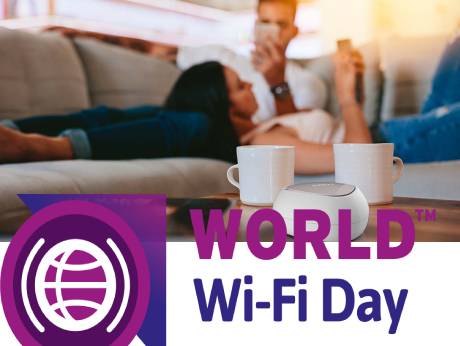
World WiFi Day feature
Extended lockdowns have pushed many Indians to “work from home”, while family members found entertainment and education at the end of an Internet connection. Will home WiFi be the new normal?
Jun 20 2020: The Wireless Broadband Alliance, a global association of Internet and data service providers, observes June 20 every year as World Wi-Fi Day.
It celebrates the phenomenal role that Wi-Fi plays in our life by connecting people & things, by enabling affordable internet access to bridge the digital divide and by contributing significant economic value. The sad fact is, 4 billion -- more than half the world’s population – still have no internet access.
This year, supporting organisations of World Internet Day in India include, Reliance Jio, TCS, FICCI, Indian Service Providers Association of India, Railtel, and the governments of Delhi, Karnataka and Telangana. In many cities worldwide, the day is marked by free Internet access, while 20 cities globally, do that all year-round.
In India it is all talk, little action: the National Digital Communication Policy ( 2018) of the Government of India, set the goal of achieving Universal broadband connectivity at 50 MBPS to every citizen by 2022. This was to be achieved by NagarNet: establishing 1 Million public Wi-Fi hotspots in urban areas and JanWiFi: 2 Million Wi-Fi hotspots in rural areas. Two years down the road these targets seem distant and over ambitious. City-wide Internet has been a nonstarter; the only success has been in railway station WiFi, a joint initiative of Railtel and Google (the latter is now exiting), which saw 200-plus stations offering free WiFi access.
Home WiFi takes off
While the government is still to deliver on its promises, the rest of us have not waited. The recent lockdown forced millions of professionals to work from home and their family members to find entertainment and education at the end of an Internet connection. Consequently, home WiFI has seen a sharp upward spike, not least because TV has also gone ‘smart’ offering hundreds of pay-and-use channels of movies, serials and music. Broadband data providers including Airtel, Jio and ACT have tapped into this Internet-TV sangam, offering their own TV “sticks” which bundle the basic broadband connection with a bouquet of TV-based infotainment. In the process, they are competing with early entrants in Android TV service like Amazon’s Fire TV stick and Google’s Chromecast as well as international services like Netflix.
Router is the key
The backbone of all these services is the router which connects to the optical data cable from your data service provider and creates a wireless hotspot in your home. Most routers sold in India have two or four antennas and work to theWiFi standard known as 802.11 ac with top data speeds of 1000 MBPS. This has retrospectively been named WiFi 5 mainly because the latest standard is now called WiFi6…. promising a five-to seven-fold increase in data speed.
Netgear was the first to bring a WiFi 6 router to India about a year ago. You may not reap immediate benefits because a WiFi 6 router needs to be matched by WiFi6 hardware at the receiving end -- in your PC, laptop, smartphone or TV -- and as of now there are few such devices that have upgraded. You can get very reasonable coverage and consistent speeds up to 70-80 MBPS with the earlier “ac” generation of routers from D-Link, Linksys, Tenda, Asus, TP-Link etc for around Rs 2000-3000. But in modern apartments with concrete walls, the signal may not reach the farthest rooms.
-----------------------------------------------------------------------
Read our story on Netgear Nighthawk WiFi6 routers
-----------------------------------------------------------------------
If so, you need to spend a bit more and go for a combo of Mesh Routers. This is how they work: You buy 2 or 3 Mesh routers in a pack. Use one as the mother router and place the second in a further spot of your home. They will ‘mesh’ with each other and extend the reach of your home hotpot. If your home is duplex, buy a 3-router combo and place the third router upstairs.
D-Link’s COVR Mesh router ( see image above) is a good example.
-----------------------------------------------------------------------------------
See our Image of the Day story on the Tenda Mesh router
------------------------------------------------------------------------------------
WiFi 6E is here
It used to be said: ‘If it works, it’s obsolete’. By the time you order and install one device, it has undergone an update. Even as we speak, WiFi6 has seen a small upgrade. While all earlier WiFi devices work in 2 alternative bands 2.4 GHz and 5 GHz, the new WiFi 6E standard uses a third band recently cleared for lay users like us: 6 GHz. So, what’s the big deal? More bandwidth means, not faster data speed, but larger chunks of data moving at the same time. If that sounds complicated think of it this way: Lockdown has taught us that it is not easy to do your office work, especially on video conference, if munna is watching a movie and daadimaa is doing a whatsapp video call with her grand kids in the US. With WiFi 6E, it won’t matter. The more the merrier!
ANAND PARTHASARATHY